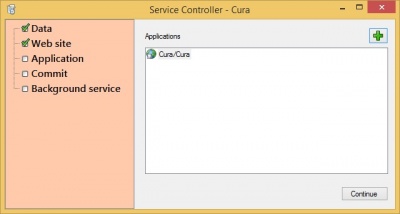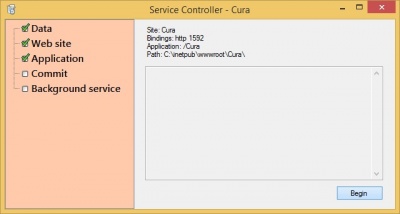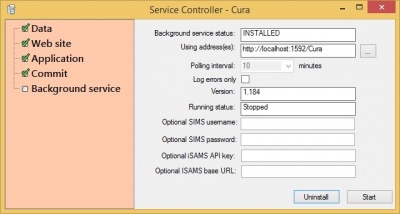Installation & version updates
Contents
Step 1 - Prerequisites
Server Specification
We recommend the following specs for your web server hosting Cura:
- 2GB RAM
- 2 Cores
Microsoft.Net Framework
You will need to have Microsoft.Net Framework, version 4.0 or later installed in order to use Cura.
NOTE: It is important that on the IIS server the order of installation is Windows -> Webserver software -> .net Framework
Microsoft Internet Information Services (IIS)
Your web server must have IIS version 7.0 or later installed. In addition to this, the following IIS features must be present:
Web Server
- Common HTTP Features
- Static Content
- Default Document
- HTTP Errors
- HTTP Redirection
- Application Development
- ASP .NET
- .Net Extensibility
- ASP
- ISAPI Extensions
- ISAPI Filters
- Security
- Windows Authentication
- Management Tools
- IIS Management Console
- IIS Management Scripts and Tools
- IIS 6 Management Compatibility
- IIS 6 Metabase Compatibility
Step 2 - The Service Controller
Log in to our website, www.tascsoftware.co.uk, using the login details that were sent to you when you purchased Cura. If you have lost your details, please contact us on 01902 824281.
Once you have logged in, click on the "Downloads" link at the top of our website. Download and run the latest Cura service pack on your IIS server. Once you have accepted the licence agreement, the installation will unpack and begin.
The Service Controller will open, which is the program installs and updates the Cura database and website. There are three options on the left side, each explained below. You should work through these from top to bottom.
Application Tier
This node is used to configure a website. You can either use one of the existing web sites listed in the left hand panel, or add a new site. If you add a new site you will be asked to specify the site name, the listening port (which should not collide with any existing sites or services), and an SSL certificate if any such are present (or choose (none) if you are going to install this at a later date).
Additionally, you need to specify a folder on the IIS server where the application files will be stored. It is important to choose a location that the IIS user (NetworkService) will have permissions to read. It is recommended to create a folder called CURA inside inetpub\wwwroot.
Once you have chosen your site, you can add an application to that site. There are no options for this stage.
Commit
Next click on the Commit node. Click the "Begin" button to commit the changes to your Cura application. This process needs to be performed each time a Cura service pack is run on the web server.
Once the commit process has completed, Cura will open in your server's default internet browser. If this happens, your update/installation has worked successfully.
Background Service
Running status
This tells you whether or not Cura will be performing important automated processes. Follow the three steps below in order.
- If the "Version" field includes the text "Update available" then click the "Uninstall" button at the bottom right.
- If the "Running status" field is blank, click the "Install" button at the bottom right.
- If the "Running status" field says "Stopped" then click the "Start" button at the bottom right.


